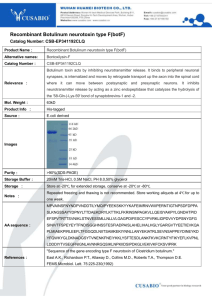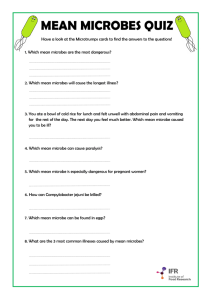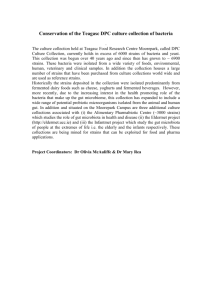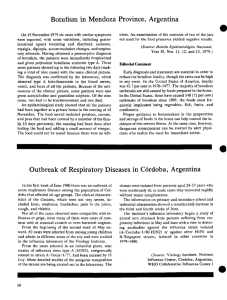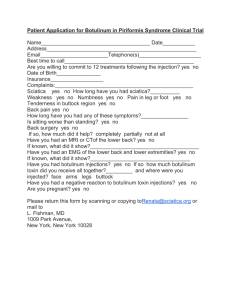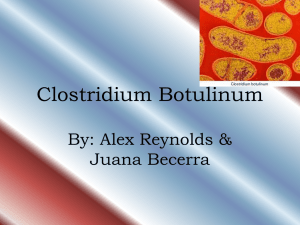Redalyc.Phenotypic characterization of Clostridium botulinum
advertisement
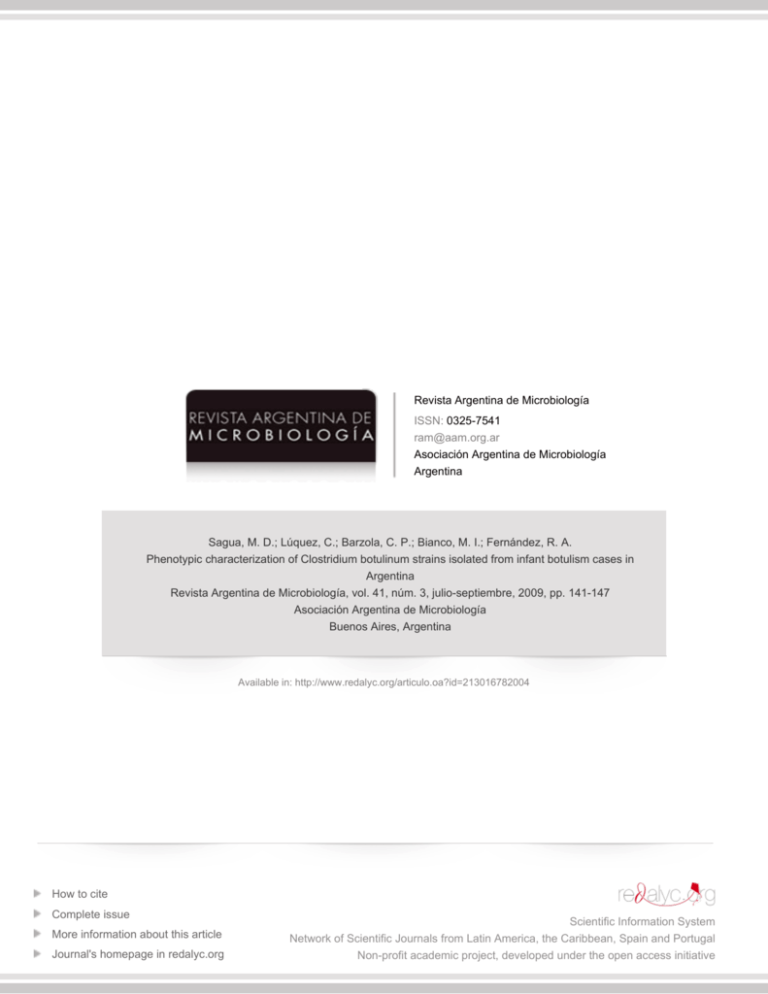
Revista Argentina de Microbiología ISSN: 0325-7541 ram@aam.org.ar Asociación Argentina de Microbiología Argentina Sagua, M. D.; Lúquez, C.; Barzola, C. P.; Bianco, M. I.; Fernández, R. A. Phenotypic characterization of Clostridium botulinum strains isolated from infant botulism cases in Argentina Revista Argentina de Microbiología, vol. 41, núm. 3, julio-septiembre, 2009, pp. 141-147 Asociación Argentina de Microbiología Buenos Aires, Argentina Available in: http://www.redalyc.org/articulo.oa?id=213016782004 How to cite Complete issue More information about this article Journal's homepage in redalyc.org Scientific Information System Network of Scientific Journals from Latin America, the Caribbean, Spain and Portugal Non-profit academic project, developed under the open access initiative Phenotypic characterization of Clostridium botulinum strains 141 ISSN 0325-7541 Revista Argentina de Microbiología (2009) 41: 141-147 ARTÍCULO ORIGINAL Phenotypic characterization of Clostridium botulinum strains isolated from infant botulism cases in Argentina M. D. SAGUA*, C. LÚQUEZ1, C. P. BARZOLA, M. I. BIANCO, R. A. FERNÁNDEZ Área Microbiología, Departamento de Patología, Facultad de Ciencias Médicas, Universidad Nacional de Cuyo. Centro Universitario, Parque General San Martín S/N (5500) Mendoza, Argentina *Correspondence. E-mail: mdsagua@yahoo.com ABSTRACT Infant botulism is the most common form of human botulism; however, its transmission has not been completely explained yet. Some of the most recognized potential sources of Clostridium botulinum spores are the soil, dust, honey and medicinal herbs. In Argentina, 456 cases of infant botulism were reported between 1982 and 2007. C. botulinum type A was identified in 455 of these cases whereas type B was identified in just one case. However, in Argentina, types A, B, E, F, G, and Af have been isolated from environmental sources. It is not clearly known if strains isolated from infant botulism cases have different characteristics from strains isolated from other sources. During this study, 46 C. botulinum strains isolated from infant botulism cases and from environmental sources were typified according to phenotypic characteristics. Biochemical tests, antimicrobial activity, and haemagglutinin-negative botulinum neurotoxin production showed uniformity among all these strains. Despite the variability observed in the botulinum neurotoxin’s binding to cellular receptors, no correlation was found between these patterns and the source of the botulinum neurotoxin. However, an apparent geographical clustering was observed, since strains isolated from Argentina had similar characteristics to those isolated from Italy and Japan, but different to those isolated from the United States. Key words: infant botulism; phenotypic characterization; Clostridium botulinum RESUMEN Caracterización fenotípica de cepas de Clostridium botulinum aisladas de casos de botulismo del lactante en Argentina. El botulismo del lactante es la forma más común del botulismo humano; sin embargo, su forma de transmisión no ha sido totalmente explicada. El suelo, el polvo ambiental, la miel y algunas hierbas medicinales son potenciales fuentes de esporas de Clostridium botulinum. Entre 1982 y 2007 se informaron en Argentina 456 casos de botulismo del lactante, 455 casos debidos al serotipo A y uno al serotipo B. Sin embargo, los serotipos A, B, E, F, G y Af han sido aislados de suelos y otras fuentes en Argentina. No se conoce si las cepas aisladas de casos de botulismo del lactante poseen características diferentes de las cepas aisladas de otras fuentes. Durante este estudio se caracterizaron 46 cepas de C. botulinum. Las pruebas bioquímicas y de sensibilidad a los antimicrobianos y la producción de neurotoxina botulínica hemaglutinina-negativa mostraron uniformidad entre estas cepas. A pesar de la variabilidad observada respecto de la unión de la neurotoxina a receptores celulares, no se observó una correlación entre estos patrones de unión y la fuente de aislamiento. Sin embargo, se observó una aparente agrupación geográfica, ya que las cepas aisladas en Argentina tuvieron características similares a las observadas en las cepas aisladas en Italia y Japón, pero diferentes de las que se registraron en las cepas aisladas en los Estados Unidos. Palabras clave: botulismo del lactante, caracterización fenotípica, Clostridium botulinum INTRODUCTION Clostridium botulinum is the principal causal agent of infant botulism, a severe neurological disease that affects infants under one year of age. In addition, some unusual neurotoxigenic Clostridium baratii and Clostridium butyricum strains have also been isolated from infant botulism cases (2, 14, 25, 26). Ingested botulinum spores germinate, colonize the large intestine and produce the botulinum neurotoxin (BoNT) in situ. The absorbed BoNT is carried to peripheral cholinergic synapses and prevents 1 Present address: Enteric Diseases Laboratory Branch, Centers for Disease Control and Prevention, Atlanta, Georgia, USA acetylcholine release, producing a descending, symmetric, flaccid paralysis. Severely ill patients are at risk of respiratory failure and require hospitalization for up to two months. Meticulous supportive and respiratory care in an intensive-care setting is the indicated case management (1). C. botulinum produces seven botulinum neurotoxins designated A through G, but only BoNT types A, B, E, and F have been reported as the cause of botulism in humans. Types C and D produce disease in animals, and type G has been isolated from soil and from cases of unexplained deaths in Switzerland (12, 36, 37). C. botulinum strains are usually described as belonging to one of four different groups (groups I, II, III, and IV) based on 142 metabolic characteristics (16). The composition of these groups are as follows: group I for type A strains and type B and F proteolytic strains; group II for type E strains and type B and F non-proteolytic strains; group III for type C and D strains and group IV for type G strains. Based on its phenotypic and genetic traits, it has been proposed that group IV would be named Clostridium argentinense (39). The molecular masses of all types of BoNTs are approximately 150 kDa, but in fluid cultures and contaminated foods, these toxins exist as part of large complexes (15). The smallest complex (12S, 300 kDa) consists of the BoNT and a non toxic-non haemagglutinin component (NTNH). A larger complex (16S, 500 kDa) is formed by the conjugation of the 12S toxin with components having haemagglutinin activity (HA). The largest complex (19S, 900 kDa) is a dimer of the 16S toxin. Types A, B, C, D, and G can include HA in their complex, but types E and F produce only the 12S complex. It is thought that nontoxic components of the complexes could protect the neurotoxin from the acidity and proteases in the gastrointestinal tract (40). In addition, it has been suggested that the HA components could play a critical role in the permeation of the BoNT into the intestinal epithelium (28). In Argentina, 456 infant botulism cases were reported between 1982 and 2007, and the average annual incidence of infant botulism (2.2 per 100,000 live births) (23) was similar to its incidence in the United States (1.9 per 100,000 live births) (5). Although infant botulism is the most common form of human botulism, its transmission has not been completely explained, and the most recognized potential sources of C. botulinum spores are the soil, dust, honey and medicinal herbs. In Argentina, 99.8% of the infant botulism cases was caused by C. botulinum type A, and 0.2% of them was caused by type B. However, types A, B, F, G, and Af have been isolated from environmental sources and from food-borne botulism cases (3, 22). It is not clear if strains isolated from infant botulism cases have biochemical and physiological characteristics different from strains isolated from other sources. Previous reports have suggested that some differences could exist between strains isolated from foodborne botulism and infant botulism cases (27, 33, 44). However, other studies suggest that strains isolated from diverse geographic regions have different characteristics, whether these strains are isolated from infant or from foodborne botulism cases (11, 43). Molecular techniques are powerful tools for the study of variability in clostridia species. However, biochemical characteristics and other phenotypic properties are also necessary to have a better understanding, not only about the relationships among these neurotoxigenic clostridia, but also about their inherent characteristics. Thus, the principal aim of this study was to characterize C. botulinum strains isolated from infant botulism cases, to determine if those strains have phenotypic characteristics different from those in strains isolated from other sources. Revista Argentina de Microbiología (2009) 41: 141-147 MATERIALS AND METHODS Bacterial isolates Origin and serotypes of the 46 C. botulinum strains used during this study are described in Table 1. All strains were obtained from the laboratory collection of Área Microbiología, Facultad de Ciencias Médicas, Universidad Nacional de Cuyo (Mendoza, Argentina). Toxin production Strains were cultivated in chopped-meat medium (CMM) and incubated at 31 °C for 18 h. An aliquot was cultured in a dialysis bag immersed in toxin production medium (38) and was incubated for 6 days at 32 °C. After incubation, the contents of the dialysis bags were centrifuged at 12,000 g for 10 min at 4 °C and serially diluted twofold in buffered solution, and 0.5 ml of each dilution was intraperitoneally inoculated into six mice. Deaths were recorded for 96 h, and 50% lethal doses (LD50) were calculated (32). Serologic typing Serologic typing was carried out by quantitative neutralization tests on toxic cultures using toxin levels of 20, 200, and 2,000 LD50 (13). Neurotoxin purification Toxins at high levels of toxicity were purified by a precipitation methodology described by Das Gupta & Sathyamoorthy (9). Determination of haemagglutinin activity Production of haemagglutinin-positive neurotoxins (HApositive BoNT) was detected by a microtitration method using multiwell plates (16). In addition, we studied the HA activity in different media: peptone-yeast extract-trypticase (PYT) (1.0% proteose peptone, 1.0% yeast extract, 2.0% trypticase peptone, 1.0% glucose, 0.075% cysteine, pH 7.2); PYT supplemented with green beans, CMM, brain-heart infusion broth and peptone-yeast extract-glucose (2% peptone, 1% yeast extract, 1% glucose, 0.05% cysteine, 4% saline solution, pH 7.2). Binding to cellular receptors BoNT’s binding to glycosphingolipids was analyzed by thin layer chromatography (TLC) immunostaining. Glycosphingolipids (0.3 nM) were developed on high-performance thin-layer chromatography aluminium sheet silica gel with chloroform/ methanol/CaCl2 (45:45:10). The developed plates were dipped in 0.5% polyisobutyl-methacrylate in hexane-chloroform (9:1) for 1 min and dried. The plates were incubated in PBS containing 1% of BSA (blocking buffer) for 1 h, followed by incubation with 800 µl of BoNT (obtained as described above) for 24 h at 20 °C. The plates were then washed with PBS and reacted for 1 h 30 min, at 20 °C, with 800 µl of botulinum antitoxin diluted 1:250 with blocking buffer. After washing three times with PBS, the plates were incubated for 1 h 30 min at 20 °C with 800 µl of peroxidase labeled anti-rabbit IgG antibody diluted 1:2500 with blocking buffer. After incubation, the plates were washed three times with PBS. After washing, color development was achieved in a substrate solution containing 2.8 mM 4-chloro-1-naphthol and 0.01% H2O2 in methanol–20 mM Tris–HCl buffer, pH 7.4 (1:29). The reaction was stopped after 10 min by washing the plates with PBS. Biochemical tests Strains were characterized by morphologic and biochemical assays. Production of lipase and lecithinase was observed in egg yolk agar and the proteolytic activity was observed in CMM. Conventional biochemical tests included acid production from sugars; reaction in milk, meat and gelatine; nitrate reduction; indole production and esculin hydrolysis. Also, gas-liquid Phenotypic characterization of Clostridium botulinum strains chromatography was used to identify the volatile acids produced in peptone-yeast extract-glucose medium (35). The biochemical tests were performed with tubes of anaerobic differential media as follows. Strains were inoculated in CMM and incubated for 24 h at 34 °C, in anaerobic conditions. These cultures were used to inoculate the tubes with the differential media. After 48 h of anaerobic incubation at 34 °C, an aliquot was withdrawn for testing by gas-liquid chromatography. In addition, the first pH reading of the carbohydrate fermentation tests was performed. The differential media continued in incubation up to 7 days. The second pH reading of the fermentation tests and the reading of all remaining tests were performed after the 7 day incubation. Antimicrobial activity The antimicrobial activity was tested according to the reference agar dilution method described by the Clinical and Laboratory Standards Institute (CLSI) (6), but using other more appropriate media for C. botulinum. The antibiotics tested were ampicillin, ampicillin-sulbactam, clindamycin, and metronidazole. Serial twofold dilutions of antibiotics were prepared in distilled water. Each dilution was mixed with brain-heart agar (at 50 °C) and was dispensed into a plate. The bacterial inocula were prepared as follows. Each strain was cultivated in solid media (0.4% meat extract, 1.0% glucose, 4.0% proteose peptone, 0.5% NaCl, 4.0% agar, pH 7.2) and incubated for 48 h at 34 °C in a BBL jar with an atmosphere containing 80% N2, 10% CO2, and 10% H2. Colonies were transferred to brain-heart infusion broth. The turbidity of the broth culture was adjusted to a 0.5 Mc Farland standard and 4 ml were transferred to the surface of the plated susceptibility medium and incubated for 48 h at 34 °C in a BBL jar with an atmosphere containing 80% N2, 10% CO2, and 10% H2. Fifty percent and ninety percent minimal inhibitory concentrations (MICs) were defined as the antibiotic concentrations at which 50 and 90% of the strains were inhibited, respectively. The Mann-Whitney test was used to compare the MIC among the C. botulinum strains. Results Serologic typing Serotypes of the 46 C. botulinum strains used in this study are indicated in Table 1. Determination of haemagglutinin activity We studied the production of HA-positive BoNT in the 46 strains. Toxins produced by all strains isolated from soil, environmental dust, chamomile, and botulism cases did not show HA activity. We observed HA activity in toxins produced by three out of nine laboratory standard strains: A-Hall, C-London and D-Africa, with HA titers of 128, 4, and 128, respectively. In addition, we used five different media to analyze their influence in the production of HA-positive BoNT in type A strains. In strain A-Hall, titers in PYT, PYT supplemented with green beans, peptone-yeast extract-glucose, brain-heart infusion broth, and CMM were 128, 128, 32, 16, and 8, respectively. All remaining type A strains were HA-negative in all tested media. Binding of the BoNT to cellular receptors We studied the binding of BoNT to glycosphingolipids in 25 strains types A, B, C, D, E, and F by TLC immunos- 143 Table 1. Origin and serotypes of Clostridium botulinum strains utilized during this study Strain Serotype Origin(1) A-Hall A Laboratory standard collection B-WH C-London D-Africa B C D E-Malbrán, E-Japan F-Langeland G-89, G-Briozzo BL10, BL12, BL13, BL17, BL18, BL20, BL21, BL22, BL23, BL24, BL25, BL27, BL43 BA-Berenjena, BA- E F G A Infant botulism Pepino, BA-Jardinera, BA-Queso BA-Anchoa Manz2, Manz20 AMB15 AMB268, AMB270 A F A A F Food-borne botulism M110, ER1423, F1575, M1814, M1823, M1822, ER1425 M612, M609 Ch1128 A B E Soil BA160, ER1723, T824, T843 Chamomile Environmental dust F (1) All strains were isolated in Argentina, except strains A-Hall, B-WH, CLondon, D-Africa, E- Japan, and F-Langeland. taining. Results showed differences in the binding patterns, depending on the serologic type and the presence of HA proteins in the neurotoxin complex (Table 2). In addition, type A BoNT from strains isolated from different sources showed different binding patterns. All the 13 strains isolated from infant botulism cases showed the same binding pattern. Biochemical tests All isolated strains were gram-positive rods with oval and subterminal spores. Despite the origin of the strains, biochemical characteristics were largely uniform in each metabolic group (Table 3). Moreover, strains isolated from infant botulism cases were indistinguishable from other strains in metabolic Group I. Some extent of variation was observed in the results from esculin hydrolysis and maltose fermentation among type A strains. As expected, according to biochemical test results, three type E strains 144 Revista Argentina de Microbiología (2009) 41: 141-147 Table 2. Binding of botulinum neurotoxin to glycosphingolipids Strain Glycosphingolipids GM1 LM1 GD1a GD1b A-Hall A-BL10(1) A-M110 A-Berenjena B-WH + + + + + + + - + + + + B-M612 C-London D-Africa E-Japan E-Ch1128 F-ER1723 F-Langeland F-Anchoa + + + + + + + + + - + + + + + + + + (1) GA1 sulfatides + + - + + + - + + - + + - - - All the 13 strains isolated from infant botulism cases showed the same binding pattern Table 3. Biochemical reactions of 46 Clostridium botulinum strains Test Group I(1) % Positive reactions Group II(2) Group III(3) Group IV(4) Meat digestion Motility Indole production Lecithinase production Lipase production 100 100 0 0 100 0 100 0 0 100 50 100 0 0 100 100 100 0 0 0 Esculin hydrolysis Nitrate reduction Gelatin Milk reaction Acid from: Glucose Mannitol Lactose Sucrose Maltose 90 0 100 100 0 0 0 0 0 0 0 50 0 0 100 100 100 0 0 0 87 100 0 0 0 100 50 0 0 0 0 0 0 0 0 0 0 A iB B iV 100 A, B 0 A, B, P 0 A, iB, B, iV Mannose Fatty acids produced(5): (1) Group I: A-Hall, B-WH, F-Langeland, A-BL10, A-BL12, A-BL13, A-BL20, A-BL18, A-BL17 A-BL21, ABL22, A-BL23, A-BL24, A-BL43, A-BL27, A-BL25, A-Berenjena, A-Pepino, A-Jardinera, A-Queso, F-Anchoa, A-Manz2, A-Manz20, A-AMB15, F-AMB268, F-AMB270, F-ER1723, F-ER1425, F-BA160, F-T824, F-T843, A-M110, A-ER1423, A-F1575, A-M1814, A-M1823, A-M1822, B-M612 and B-M609. (2) Group II: E-Malbrán, E-Japan and E-Ch1128. (3) Group III: C-London and D-Africa. (4) Group IV: G-89 and G-Briozzo. (5) A, acetic acid; B, butyric acid; iB, isobutyric acid; iV, isovaleric acid; P, propionic acid. corresponded to metabolic Group II, two type C and D strains corresponded to Group III, and two type G strains to Group IV. Antimicrobial activity Ampicillin and ampicillin-sulbactam MICs for the 46 C. botulinum strains were between 0.06 and 2 µg/ml, and Phenotypic characterization of Clostridium botulinum strains 145 Table 4. Comparison of 50% and 90% minimal inhibitory concentrations (MIC) among strains of Clostridium botulinum type A isolated from different sources Antimicrobial agent Ampicillin(1) Clindamycin Metronidazole Strains isolated from Infant botulism cases Other sources 50%MIC 90%MIC 50%MIC 90%MIC 0.25 16 8 0.5 32 32 0.25 16 4 1 32 16 (1) Ampicillin and ampicillin-sulbactam minimal inhibitory concentrations were identical. the 50% MIC was 0.5 µg/ml. Clindamycin MICs for those strains were between 0.5 and 64 µg/ml, and the 50% MIC was 32 µg/ml. Metronidazole MICs for the 46 strains were between 0.25 and 64 µg/ml, and the 50% MIC was 8 µg/ml. The MICs for C. botulinum type A isolated from infant botulism cases were compared with MICs for type A strains isolated from other sources (Table 4). There were no statistically significant differences between the two groups of strains. DISCUSSION Conventionally, taxonomy in Clostridium has been determined by culture, morphologic, and biochemical features, and by genotypic characteristics, as 16S RNA gene sequence and G+C contents. The sequencing of 16S RNA gene had contributed to demonstrate that Clostridium is a polyphyletic group consisting of more than 20 genera and many families (7). In particular, C. botulinum has a significant phenotypic variation, and it has been proposed that each metabolic group could be placed in a separated species. Moreover, metabolic Group IV has already been named as a different species, C. argentinense (39). Sequencing of the genes encoding 16S RNA and other molecular techniques are very powerful tools for the classification of this species. However, biochemical characteristics and other phenotypic properties are also necessary for a better understanding not only of the relationships among these neurotoxigenic clostridia, but also of their inherent characteristics. Some authors have suggested that strains isolated from infant botulism cases have some characteristics, such as the molecular size of the toxin complex, the infective dose in infant mouse intestines, and the antigenicity of the toxins, that differ from those in strains isolated from food-borne botulism cases (27, 33, 44). However, there is also evidence that strains isolated from diverse geographic regions have different characteristics, whether they are isolated from infant or food-borne botulism cases (11, 43). During this study, C. botulinum strains isolated from infant botulism and food-borne botulism cases, and from environmental sources were characterized by biochemi- cal tests, antimicrobial activity, BoNT haemagglutinin activity, and BoNT’s binding to cellular receptors. Only three strains produced HA-positive BoNT (types A, C and D), and the A-Hall strain produced the highest titers of HA-positive BoNT in PYT and PYT supplemented with green beans, and the lowest titers in CMM. These results are similar to those informed by Sugii et al. who suggested that media could influence the production of HA-positive BoNT (40, 41). The BoNT produced by other strains did not show HA activity. We did not find a correlation between the HA activity and the source of isolation (food-borne and infant botulism cases), in accordance with findings by Cordoba et al. (8) and Franciosa et al. (11). These results contrast with previous observations that HAnegative BoNT producing strains were more frequently associated with infant botulism cases (44). The non-toxic components (HA and NTNH) are considered to be important for the development of food poisoning because the non-toxic components could protect the neurotoxin from the gastric juice when the progenitor toxins pass through the stomach (30, 40). In addition, it has been suggested that HA could participate in the transport of the BoNT through the gastric layer (24). In the present work, strains isolated from cases and from environmental samples did not show HA activity. These results could be indicating that, although HA could protect the toxin and participate in the binding to the gastric cells, these activities are not fundamental to cause disease. Because all the strains isolated from local sources were HA negative, we could suggest a geographical distribution, resembling the population in Italy and Japan and a differentiation from strains isolated in the United States, where HA positive strains seem to be more frequent than HA negative strains (11, 43). Results from ganglioside binding of BoNT showed that some differences could be present among the studied strains. Results in this work showed different binding profiles independent of the serotypes and the presence of HA. Coincident with these results, other authors have reported different binding profiles, even contradictory in some cases (17-21, 29, 34, 45, 46). Some of the strains in this study had the same serotype and the same bind- 146 ing profile (e.g. E-Japan and E-Ch1128; F-Langeland and F-Anchoa), whereas other strains had the same serotype, but different binding profiles (e.g. B-WH and B-M612; ABL10 and A-M110). Despite the variability observed in the BoNT’s binding to cellular receptors, we did not find a correlation between these patterns and the source of the botulinum neurotoxin. These findings support the fact that other factors may be affecting the BoNT’s binding to cellular receptors. Biochemical tests showed uniformity among the strains isolated from infant and food-borne botulism cases, soil, environmental dust, and chamomile. Regardless of the serologic type, source or geographical location, the same fatty acids were produced, and similar reactions were observed with regard to carbohydrates fermented, gelatine and milk digestion, production of lipase, and other biochemical reactions. In addition, biochemical characteristics of these strains were similar to standard strains (4) and showed homogeneity in each metabolic group. Particularly, the strains isolated from infant botulism cases were identical to the other strains in Group I. Some of the biochemical tests varied among type A strains, but the differences did not correlate with a specific source of the strains. Ampicillin and ampicillin-sulbactam MICs were similar to those reported by other authors (10, 42). In addition, clindamycin and metronidazole MICs were similar to those reported by Pankuch et al. (31), but were higher than those reported by Swenson et al. (42). However, those authors utilized different media to test the antimicrobial activities, and this fact can explain the differences observed. In addition, Pankuch et al. (31) studied the antimicrobial susceptibility in other species of clostridia, different from C. botulinum. Ampicillin, ampicillin-sulbactam, clindamycin, and metronidazole MICs were similar for strains isolated from infant botulism cases and from other sources. In conclusion, biochemical tests, antimicrobial activity, and haemagglutinin-negative BoNT production showed uniformity among the strains isolated from infant botulism and food-borne botulism cases and from environmental sources. Despite the variability in BoNT’s binding patterns, no correlation was found between a binding pattern and the source of the toxin. These observations could suggest that these infant botulism strains have not specific particular biochemical characteristics. Moreover, these results could indicate that strains isolated from a geographic region could have specific / particular characteristics, depending on whether these strains are isolated from botulism cases, soil, or other sources. Acknowledgements: We thank Romina Comín, at Centro de Investigaciones en Química Biológica de Córdoba (CIQUIBIC, UNC-CONICET), Departamento de Química Biológica, Facultad de Ciencias Químicas, Universidad Nacional de Córdoba. This work was supported by grants from Facultad de Ciencias Médicas and Secretaría de Ciencia y Técnica, Universidad Nacional de Cuyo. C Lúquez and MI Bianco had fellowship assistance from CONICET. Revista Argentina de Microbiología (2009) 41: 141-147 REFERENCES 1. Arnon SS. Infant botulism. In: Feigen RD, Cherry JD, Demmler GJ, Kaplan SL, editors. Textbook of Pediatric Infectious Disease. Philadelphia, WB Saunders, 2004, p. 1758-66. 2. Aureli P, Fenicia L, Pasolini B, Gianfranceschi M, McCroskey LM, Hatheway CL. Two cases of type E infant botulism caused by neurotoxigenic Clostridium butyricum in Italy. J Infect Dis 1986; 154: 207–11. 3. Bianco MI, Lúquez C, de Jong LIT, Fernández RA. Presence of Clostridium botulinum spores in Matricaria chamomilla (chamomile) and its relationship with infant botulism. Int J Food Microbiol 2008; 121: 357-60. 4. Cato EP, George WL, Finegold SM. In: Sneath PHA, Mair NS, Sharpe ME, Holt JG, editors. Bergey’s Manual of Systematic Bacteriology, Vol. 2, Baltimore, Williams and Wilkins Co, 1986, p. 1141-200. 5. Centers for Disease Control and Prevention. Botulism in the United States, 1899-1996. Handbook for epidemiologists, clinicians and laboratory workers. Centers for Disease Control and Prevention, Atlanta, 1998. 6. Clinical and Laboratory Standards Institute. Methods for Antimicrobial Susceptibility Testing of Anaerobic Bacteria; Approved Standard - Seventh edition, 2007; M11-A7. Wayne, PA, USA. 7. Collins MD, Lawson PA, Willems A, Córdoba JJ, Fernández-Garayzabal J, García P, et al. The phylogeny of the genus Clostridium : Proposal of five new genera and eleven new species combinations. Int J Syst Bacteriol 1994; 44: 812-26. 8. Cordoba JJ, Collins MD, East AK. Studies on the genes encoding botulinum neurotoxin type A of Clostridium botulinum from a variety of sources. System Appl Microbiol 1995; 18: 13-22. 9. DasGupta BR, Sathyamoorthy V. Purification and amino acid composition of type A botulinum neurotoxin. Toxicon 1984; 3: 415-24. 10. Dezfulian M, Dowell VR. Cultural and physiological characteristics and antimicrobial susceptibility of Clostridium botulinum isolated from foodborne and infant botulism cases. J Clin Microbiol 1980; 11: 604-9. 11. Franciosa G, Floridi F, Maugliani A, Aureli P. Differentiation of the gene clusters encoding botulinum neurotoxin type A complexes in Clostridium botulinum type A, Ab, and A(B) strains. Appl Environ Microbiol 2004; 70: 7192-9. 12. Giménez DF, Ciccarelli AS. Another type of Clostridium botulinum. Zentralbl Bakteriol Parasitenkd Infektionskr Abt Orig 1970; 215: 215-20. 13. Giménez DF, Giménez JA. In: Das Gupta BR, editor. Botulinum and Tetanus Neurotoxins. New York, Plenum Press, 1993, p. 421-31. 14. Hall JD, McCroskey LM, Pincomb BJ, Hatheway CL. Isolation of an organism resembling Clostridium baratii which produces type F botulinal toxin from an infant with botulism. J Clin Microbiol 1985; 21: 654-5. 15. Hatheway CL. Toxigenic clostridia. Clin Microbiol Rev 1990; 3: 66-98. 16. Holdeman LV, Brooks JB. In: Hetzberg M, editor. Proceedings of the First U. S. - Japan Conference of Toxic Microorganisms. Washington DC, 1970, p. 278-86. 17. Inoue K, Fujinaga Y, Honke K, Ypkota K, Ikeda T, Ohyama T, et al . Characterization of haemagglutinin activity of Clostridium botulinum type C and D 16S toxins, and one subcomponent of haemagglutinin (HA1). Microbiology 1999; 145: 2533-42. 18. Inoue K, Fujinaga Y, Honke K, Arimitsu H, Mahmut N, Sakaguchi Y, et al. Clostridium botulinum type A haemagglutinin-positive progenitor toxin (HA+-PTX) binds to Phenotypic characterization of Clostridium botulinum strains 19. 20. 21. 22. 23. 24. 25. 26. 27. 28. 29. 30. 31. oligosaccharides containing Galβ1–4GlcNAc through one subcomponent of haemagglutinin (HA1). Microbiol 2001; 147: 811-9. Kamata Y, Yoshimoto M, Kozaki S. Interaction between botulinum neurotoxin type A and ganglioside: ganglioside inactivates the neurotoxin and quenches its tryptophan fluorescence. Toxicon 1997; 35: 1337-40. Kamata Y, Kimura Y, Hirio T, Sakaguchi G, Kozaki S. Purification and characterization of the ganglioside-binding fragment of Clostridium botulinum type E neurotoxin. Biochim Biophys Acta 1993; 1156: 213-8. Kozaki S, Ogasawara J, Shimote Y, Kamata Y, Sakaguchi G. Antigenic structure of Clostridium botulinum type B neurotoxin and its interaction with gangliosides, cerebroside, and free fatty acids. Infect Immun 1987; 55: 3051-6. Lúquez C, Bianco MI, de Jong LIT, Sagua MD, Arenas GN, Ciccarelli AS, et al. Distribution of botulinum toxin-producing clostridia in soils of Argentina. Appl Environ Microbiol 2005; 71: 4137-9. Lúquez C, Bianco MI, Sagua MD, Barzola CP, de Jong LIT, Degarbo SM, et al. Relationship between the Incidence of infant botulism and the presence of botulinum-toxin producing clostridia in the soil of Argentina from 1982-2005. J Pediatr Neurol 2007; 5: 279-86. Matsumura T, Jin Y, Kabumoto Y, Takegahara Y, Oguma K, Lencer WI, et al. The HA proteins of botulinum toxin disrupts intestinal epithelial intercellular junctions to increase toxin absorption. Cell Microbiol 2007; 10: 355-64. McCroskey LM, Hatheway CL, Fenicia L, Pasolini B, Aureli P. Characterization of an organism that produces type E botulinal toxin but which resembles Clostridium butyricum from the feces of an infant with type E botulism. J Clin Microbiol 1986; 23: 201-2. McCroskey LM, Hatheway CL, Woodruff BA, Greenburg JA, Jurgenson P. Type F botulism due to neurotoxigenic Clostridium baratii from un unknown source in an adult. J Clin Microbiol 1991; 29: 2618-20. Minton NP. Molecular genetics of clostridial neurotoxins. Curr Top Microbiol Immunol 1995; 195: 161-94. Niwa K, Koyama K, Inoue S, Suzuki T, Hasegawa K, Watanabe T, et al. Role of nontoxic components of serotype D botulinum toxin complex in permeation through a Caco-2 cell monolayer, a model for intestinal epithelium. FEMS Immunol Med Microbiol 2007; 49: 346-52. Ochanda JO, Syuto B, Ohishi I, Naiki M, Kubo S. Binding of Clostridium botulinum neurotoxin to gangliosides. J Biochem 1986; 100: 27-33. Oishi I, Sugii S, Sakaguchi G. Oral toxicities of Clostridium botulinum toxins in response to molecular size. Infect Immunol 1977; 16: 107-9. Pankuch GA, Jacobs MR, Appelbaum PC. Susceptibilities of 428 gram-positive and -negative anaerobic bacteria to bay y3118 compared with their susceptibilities to ciprofloxacin, clindamycin, metronidazole, piperacillin, piperacillin-tazobactam, and cefoxitin. Antimicrob Agents Chemother 1993; 8: 1649-54. 147 32. Reed LJ, Muench H. A simple method for estimating fifty percent end points. Am J Hyg 1938; 27: 493-7. 33. Sakaguchi G, Sakaguchi S, Kamata Y, Tabita K, Asao T, Kozaki S. Distinct characters of Clostridium botulinum type A strains and their toxin associated with infant botulism in Japan. Int J Food Microbiol 1990; 11: 231-41. 34. Schengrund CL, Ringler NJ, DasGupta BR. Adherence of botulinum and tetanus neurotoxins to ganglioside GT1b and derivatives thereof. J Neurochem 1991; 57: 1024-32. 35. Smith GR, Young AM. Clostridium botulinum in British soil. J Hyg 1980; 85: 271-4. 36. Sonnabend O, Sonnabend W, Heinzle R, Sigrist T, Dirnhofer R, Krech U. Isolation of Clostridium botulinum type G and identification of botulinal toxin in humans: report of five sudden unexpected deaths. J Infect Dis 1981; 143: 22-7. 37. Sonnabend WF, Sonnabend UP, Krech T. Isolation of Clostridium botulinum type G from Swiss soil specimens by using sequential steps in an identification scheme. Appl Environ Microbiol 1987; 53: 1880-4. 38. Sterne M, Wentzel LM. A new method for the large-scale production of high-titre botulinum formol-toxoid types C and D. J Inmunol 1950; 65: 175-83. 39. Suen JC, Hatheway CL, Steigerwalt AG, Brenner DJ. Clostridium argentinense , sp. nov.: a genetically homogeneous group composed of all strains of Clostridium botulinum toxin type G and some nontoxigenic strains previously identified as Clostridium subterminale or Clostridium hastiforme. Int J Syst Bacteriol 1988; 38: 375-81. 40. Sugii S, Ohishi I, Sakaguchi G. Correlation between oral toxicity and in vitro stability of Clostridium botulinum type A and B toxins of different molecular sizes. Infect Immunol 1977; 16: 910-4. 41. Sugii S, Ohishi I, Sakaguchi G. Molecular sizes of botulinum toxins in foods. Japan J Med Sci Biol 1978; 31: 159-61. 42. Swenson JM,Thornsberry C, McCroskey LM, Hatheway CL, Dowell VR. Susceptibility of Clostridium botulinum to thirteen antimicrobial agents. Antimicrob Agents Chemother 1980; 18: 13-9. 43. Tabita K, Sakaguchi S, Kozaki S, Sakaguchi G. Comparative studies on Clostridium botulinum type A strains associated with infant botulism in Japan and in California, USA. Jpn J Med Sci Biol 1990; 43: 219-31. 44. Tabita K, Sakaguchi S, Kosaki S, Sakaguchi G. Distinction between Clostridium botulinum type A strains associated with food-borne botulism and those with infant botulism in Japan in intraintestinal toxin production in infant mice and some other properties. FEMS Microbiol Lett 1991; 79: 251-6. 45. Takamizawa K, Iwamori M, Kozaki S, Sakaguchi G, Tanaka R, Takayama H, et al. TLC immunostaining characterization of Clostridium botulinum type A neurotoxin binding to gangliosides and free fatty acids. FEBS Lett 1986; 201: 229-32. 46. Yowler BC, Schengrund CL. Glycosphingolipids-sweets for botulinum neurotoxin. Glycocon J 2004; 21: 287-93. Recibido: 13/01/09 – Aceptado: 14/07/09
